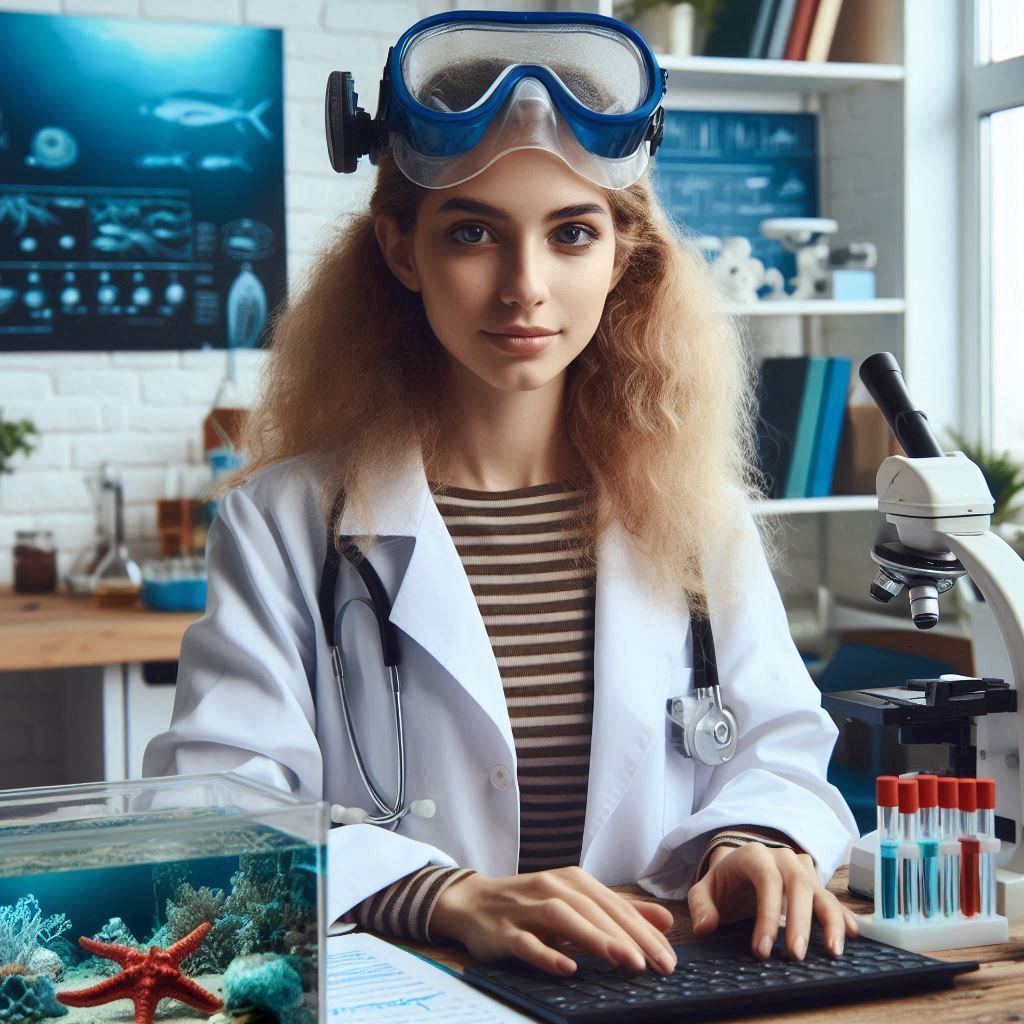Introduction
Marine biology research requires the use of advanced equipment and tools to study the vast and often inaccessible ocean environments.
These specialized tools are essential for researchers to collect accurate data, conduct detailed observations, and explore areas of the ocean that are otherwise impossible to reach.
The complexity and scale of marine ecosystems demand precise instruments to understand the interactions between marine species, track their behaviors, and analyze environmental changes.
Using specialized equipment in marine biology research is crucial for ensuring the quality and reliability of the data gathered.
Traditional research methods alone are not sufficient for navigating the depths of the ocean or studying marine organisms in their natural habitats.
These tools allow scientists to dive deeper, capture high-resolution imagery, and gather detailed measurements, all of which contribute to a clearer understanding of marine life and ocean health.
As ocean ecosystems face increasing threats from climate change and pollution, the role of these tools becomes even more critical.
In this blog post, we will discuss the essential types of marine biology research equipment, from underwater drones and remotely operated vehicles (ROVs) to submersibles, sonar systems, and water sampling devices.
Each of these tools plays a unique role in helping researchers explore the oceans and uncover new discoveries.
We will also explore the latest advancements in research technology and how they continue to revolutionize the field of marine biology.
By the end, you‘ll understand how these tools enable scientists to push the boundaries of ocean exploration and deepen their understanding of marine ecosystems.
Microscopes and imaging tools
The Importance of Microscopes in Studying Marine Life
Microscopes are essential for understanding marine life on a cellular level.
They allow researchers to observe microscopic organisms and structures that would otherwise remain invisible.
Studying tiny organisms, like plankton or algae, provides valuable insights into marine ecosystems.
Through microscopes, scientists can analyze the biology, behavior, and evolution of marine species.
This knowledge is crucial for understanding the health and function of ocean environments.
Overview of Different Types of Microscopes Used in Marine Biology Research
Marine biology utilizes various types of microscopes, each serving a specific purpose.
Light microscopes are the most common and help magnify small marine organisms, revealing important details like cell structures.
Dissecting microscopes provide a three-dimensional view, making them ideal for studying larger marine animals or their external anatomy.
Fluorescence microscopes, another key tool, use fluorescent dyes to highlight particular structures, helping researchers study cellular components in more detail.
Electron microscopes, both scanning and transmission types, provide high-resolution images of organisms at the molecular level, allowing researchers to observe the smallest biological structures in the ocean.
Discussion on Imaging Tools Such as Underwater Cameras and Sonar Systems
In addition to microscopes, imaging tools like underwater cameras and sonar systems play an essential role in marine biology research.
Underwater cameras, often attached to remotely operated vehicles (ROVs) or carried by divers, allow researchers to capture high-resolution images and videos of marine life in its natural environment.
These tools help scientists observe behaviors, track species movements, and monitor changes in marine habitats over time.
Sonar systems use sound waves to map the seafloor, track marine species, and explore areas where visibility is low.
By measuring sound wave echoes, sonar helps scientists gather data on species distribution and underwater landscapes, which is critical for understanding deep-sea ecosystems.
Together, microscopes and imaging tools provide marine biologists with the means to study both the smallest and largest aspects of ocean life, driving critical discoveries about marine ecosystems.
Read: U.S. Cities with the Most Opportunities for Environmental Scientists
Sampling equipment
The Need for Collecting Samples in Marine Biology Research
Collecting samples is essential in marine biology research because it provides tangible data for studying marine ecosystems.
Samples allow researchers to analyze water quality, species diversity, and the health of organisms.
By collecting physical samples from the ocean, scientists gain insights into various marine processes such as nutrient cycles, pollution levels, and ecosystem functioning.
Sampling is crucial for understanding biodiversity, tracking environmental changes, and assessing the impact of human activities on marine life.
Description of Sampling Equipment Like Nets, Trawls, and Corers
Marine biologists use a range of equipment to collect samples from the ocean.
Nets are one of the most common tools, used to capture small organisms like plankton or fish.
These fine-mesh nets are designed to filter through water and trap specific species for further study.
Trawls are larger nets that can be dragged along the ocean floor to catch a wide variety of marine organisms.
This method is particularly useful for studying benthic species that live near the seabed.
Corers are another critical sampling tool, used to collect sediment samples from the seafloor.
By retrieving cores of sediment, scientists can study layers of organic material, pollutants, and other components to gain insights into the history and composition of marine environments.
Importance of Properly Collecting and Preserving Samples for Analysis
Proper collection and preservation of samples are vital to ensuring accurate research results.
When collecting samples, researchers must follow specific protocols to prevent contamination or degradation.
This is especially important when studying delicate organisms or chemical properties of water and sediments.
Preserving samples in appropriate conditions, such as freezing or chemical stabilization, ensures that they remain viable for analysis in the lab.
Properly preserved samples allow scientists to conduct detailed examinations, which lead to reliable data and valuable insights into marine ecosystems.
This process is key to advancing marine biology research and understanding the ocean’s complex dynamics.
Read: Environmental Scientist vs. Ecologist: Roles and Differences in the US
Environmental monitoring devices
The Use of Sensors and Data Loggers in Monitoring Environmental Conditions
Environmental monitoring devices, such as sensors and data loggers, are crucial tools for marine biologists.
These devices allow researchers to continuously collect data on various environmental parameters.
Sensors measure specific conditions like water temperature, pH, salinity, and dissolved oxygen levels.
Data loggers store this information over time, providing a comprehensive view of environmental changes.
By using these devices, scientists can monitor the health of marine ecosystems, assess the effects of climate change, and track pollution levels.
Continuous data collection is vital for understanding long-term environmental trends in the ocean.
How These Devices Help Researchers Track Changes in Water Temperature, pH, and Salinity
Monitoring devices play an essential role in tracking key environmental variables such as water temperature, pH, and salinity.
Changes in water temperature can affect marine species‘ survival, reproduction, and migration patterns.
Temperature sensors allow scientists to detect these shifts and study their impact on marine ecosystems.
pH sensors are used to monitor ocean acidification, a growing concern due to increased carbon dioxide absorption by the ocean.
This acidification harms marine life, especially organisms with calcium carbonate shells.
Salinity sensors measure the salt concentration in seawater, which can influence species distribution and ocean circulation.
These tools enable researchers to gather real-time data, offering valuable insights into ocean dynamics and environmental health.
Importance of Using Reliable Monitoring Equipment for Accurate Data Collection
Using reliable and accurate environmental monitoring equipment is crucial for obtaining precise data.
Faulty or poorly calibrated devices can lead to inaccurate readings, which may compromise research outcomes.
Reliable sensors and data loggers ensure that researchers can trust the data they collect, leading to valid conclusions and actionable insights.
Consistent monitoring with accurate equipment helps scientists detect subtle changes in marine environments and respond to emerging threats such as pollution, overfishing, or climate change.
Reliable equipment also allows for long-term studies, ensuring that collected data can be used to track trends and make informed decisions about marine conservation and management.
Read: The Relationship Between U.S. Policy & Environmental Scientist Roles
DNA sequencing technology
Overview of How DNA Sequencing Is Used in Marine Biology Research
DNA sequencing has become a powerful tool in marine biology research, enabling scientists to explore the genetic makeup of marine organisms.
By sequencing DNA, researchers can identify species, understand evolutionary relationships, and study genetic diversity in marine ecosystems.
DNA sequencing helps in tracking population dynamics, discovering new species, and monitoring changes in genetic variation due to environmental stressors.
This technology has revolutionized marine biology by providing insights into the hidden genetic information of marine life, which is critical for biodiversity conservation and species management.
Explanation of the Process of DNA Extraction and Sequencing
DNA extraction and sequencing involve several key steps.
First, marine biologists collect samples from marine organisms, which can include tissue, scales, or even water for environmental DNA (eDNA) studies.
The DNA is then extracted from the sample using specialized chemicals that break open the cells and isolate the DNA.
Once extracted, the DNA is processed for sequencing.
In DNA sequencing, machines read the genetic code of the sample, breaking it down into its basic components: adenine (A), thymine (T), cytosine (C), and guanine (G).
This sequence of letters represents the organism’s genetic blueprint.
Modern sequencing technologies, such as next-generation sequencing, allow scientists to quickly and accurately read large amounts of genetic data.
The Importance of Genetic Analysis in Studying Marine Organisms and Their Habitats
Genetic analysis is crucial for understanding the biology and ecology of marine organisms.
By studying DNA, researchers can identify species with high precision, even in cases where physical identification is difficult.
This is particularly useful for cryptic species or larvae that look similar but differ genetically.
DNA sequencing also helps in studying the evolutionary history of marine species, revealing how they have adapted to their environments over time.
Genetic data are invaluable for monitoring populations, as it allows scientists to track genetic diversity, which is essential for species‘ resilience to environmental changes.
Furthermore, genetic analysis aids in studying marine ecosystems and food webs.
By analyzing eDNA from water samples, researchers can detect the presence of species without physically capturing them, offering a non-invasive method of monitoring biodiversity.
Genetic information also helps identify invasive species, assess the impact of human activities, and understand how marine populations respond to threats like climate change and overfishing.
In marine conservation, DNA sequencing guides efforts to protect endangered species and restore damaged habitats.
It provides a molecular-level understanding of marine life, driving strategies for maintaining healthy ecosystems and promoting biodiversity.
Genetic analysis is therefore an indispensable tool in modern marine biology research.
Read: Organizations & Associations for Environmental Scientists in the USA

Diving and underwater tools
Equipment Used by Divers for Underwater Research, Such as Scuba Gear and Underwater Scooters
Divers use specialized equipment to conduct underwater research, enabling them to explore marine environments directly.
Scuba gear is essential, consisting of a self-contained breathing apparatus that allows divers to stay submerged for extended periods.
Scuba gear includes air tanks, regulators, and buoyancy control devices, which provide divers with the mobility and safety needed for underwater exploration.
For enhanced mobility, divers also use underwater scooters, which are motorized devices that help them move efficiently through the water.
These scooters are particularly useful for covering large areas quickly, allowing divers to observe and collect data from a wide range of marine habitats.
Overview of Underwater Tools Like ROVs (Remotely Operated Vehicles) and AUVs (Autonomous Underwater Vehicles)
In addition to diver-operated equipment, remotely operated vehicles (ROVs) and autonomous underwater vehicles (AUVs) are essential tools for marine research.
ROVs are tethered, unmanned submersibles controlled by operators on the surface.
These vehicles are equipped with cameras, lights, and robotic arms, allowing researchers to capture high-resolution images, collect samples, and perform precise tasks at great depths.
ROVs are widely used in deep-sea exploration, where human divers cannot reach.
AUVs, on the other hand, are untethered and operate autonomously.
They are programmed to navigate underwater environments, collecting data on their own.
AUVs are valuable for mapping the seafloor, monitoring oceanographic conditions, and conducting long-term surveys in remote or hazardous areas.
Importance of Using Specialized Tools for Exploring Deep-Sea Environments
Exploring deep-sea environments requires specialized tools due to the extreme conditions of the ocean’s depths.
The deep sea is characterized by high pressure, low temperatures, and complete darkness, making it inaccessible to human divers.
Tools like ROVs and AUVs are crucial for studying these environments, as they can withstand the harsh conditions and provide invaluable data.
These tools allow researchers to explore deep-sea ecosystems, discover new species, and investigate geological features like hydrothermal vents.
By using specialized equipment, scientists can collect samples, record videos, and monitor the deep ocean in ways that were previously impossible.
The use of advanced underwater tools expands our understanding of the deep sea, a largely unexplored and mysterious part of the Earth.
Reliable equipment is essential for safe, accurate research, ensuring that data collected from these challenging environments is trustworthy.
Specialized tools open the door to discoveries that can enhance our knowledge of marine biodiversity, oceanic processes, and the overall health of the planet‘s oceans.
Transform Your Career Today
Unlock a personalized career strategy that drives real results. Get tailored advice and a roadmap designed just for you.
Start NowYou Might Also Like: Forensic Science vs. Criminology: Differences
Delve into the Subject: How Anthropologists Contribute to Policy Making
See Related Content: Marine Biology Research on Ocean Currents
Laboratory equipment
The Equipment Used in Marine Biology Laboratories, Such as Centrifuges, Incubators, and Spectrophotometers
Marine biology laboratories are equipped with various instruments that facilitate research and experimentation.
Centrifuges are crucial for separating components of biological samples based on density.
These devices spin samples at high speeds, allowing scientists to isolate cells, proteins, and other biomolecules.
Incubators provide controlled environments for growing marine organisms or conducting experiments.
They maintain optimal temperature and humidity levels, essential for the growth of sensitive marine species.
Spectrophotometers are another key piece of laboratory equipment, used to measure the concentration of substances in a solution by analyzing light absorption.
This instrument plays a vital role in analyzing water quality, nutrient levels, and other chemical properties.
How These Instruments Are Used for Analyzing Samples and Conducting Experiments
Laboratory equipment serves specific functions in analyzing samples and conducting experiments.
Centrifuges help marine biologists extract DNA, RNA, and proteins from marine organisms for further study.
This separation is critical for genetic analysis and understanding cellular functions.
Incubators allow researchers to culture marine microbes, algae, or even fish larvae under controlled conditions.
This helps scientists study growth rates, reproductive cycles, and responses to environmental changes.
Spectrophotometers assist in measuring light absorbance, enabling researchers to determine concentrations of chlorophyll, nutrients, or pollutants in water samples.
By using these instruments, scientists can gather precise data, leading to informed conclusions and discoveries in marine biology.
Importance of Having Well-Equipped Laboratories for Marine Biology Research
Having well-equipped laboratories is essential for advancing marine biology research.
Adequate laboratory facilities enable scientists to conduct experiments, analyze samples, and process data effectively.
A fully equipped lab enhances the quality of research by providing the necessary tools for accurate and reliable measurements.
Well-maintained equipment ensures that experiments yield consistent results, which is crucial for reproducibility in scientific research.
Furthermore, advanced laboratory tools enable researchers to explore complex marine systems and address pressing environmental issues.
Access to cutting-edge technology fosters innovation and encourages collaborative research efforts, ultimately contributing to our understanding of marine ecosystems and their conservation.
In summary, well-equipped marine biology laboratories are vital for supporting scientific inquiries and expanding our knowledge of the ocean’s diverse life forms and ecosystems.
Discover More: Ethnobotany: Studying the Cultural Uses of Plants
Navigation and mapping tools
Navigation Tools Like GPS Systems and Compasses Used in Marine Research Vessels
First, Navigation is crucial for marine research vessels, as accurate positioning is essential for effective exploration.
GPS systems are the backbone of modern navigation, providing precise location data.
These systems enable researchers to plot courses, identify study sites, and collect data efficiently.
Alongside GPS, traditional compasses remain important for basic navigation, especially in remote areas where GPS signals may be unreliable.
Together, these tools ensure that marine biologists can navigate vast ocean areas safely and accurately, facilitating systematic data collection and exploration.
Overview of Mapping Tools Such as GIS (Geographic Information System) Software and Bathymetric Sensors
Mapping tools play a vital role in understanding marine ecosystems.
Geographic Information System (GIS) software allows researchers to visualize, analyze, and interpret spatial data.
Scientists use GIS to map habitats, track species distributions, and assess environmental changes over time.
Bathymetric sensors are another key mapping tool, measuring the depth of water bodies and mapping the underwater topography.
These sensors provide detailed information about seafloor features, including underwater mountains, valleys, and habitats.
Together, GIS and bathymetric sensors offer a comprehensive understanding of marine environments, supporting effective management and conservation efforts.
Importance of Accurate Navigation and Mapping in Studying Marine Ecosystems
Accurate navigation and mapping are critical in studying marine ecosystems for several reasons.
First, they ensure that researchers can locate specific sites and repeat studies over time.
Consistent data collection from the same locations allows for valid comparisons and assessments of changes in marine life and habitats.
Second, precise mapping enables scientists to identify important ecological features, such as coral reefs, seagrass beds, and spawning grounds.
Understanding the spatial relationships between these habitats is essential for effective conservation strategies.
Furthermore, accurate navigation and mapping support the development of marine protected areas (MPAs).
By identifying critical habitats and species distributions, researchers can advocate for protections in areas that need conservation.
Additionally, having reliable mapping data helps in assessing human impacts on marine ecosystems, such as pollution and habitat degradation.
Navigation and mapping tools are indispensable for marine research.
They enhance our understanding of complex marine ecosystems and support efforts to preserve biodiversity and maintain the health of the ocean.
Accurate navigation and mapping ultimately contribute to more informed and effective marine conservation strategies.
Conclusion
Marine biology research requires a range of specialized tools and equipment to explore and understand ocean ecosystems effectively.
Throughout this blog, we discussed key equipment like underwater drones, submersibles, and water samplers, which provide researchers with crucial data from deep-sea environments.
Advanced imaging devices, sonar systems, and CTD sensors also play a vital role in mapping ocean floors and tracking marine species with precision.
Each tool serves a specific purpose, contributing to a comprehensive understanding of marine life.
The importance of using specialized equipment in marine biology research cannot be overstated.
These tools not only allow researchers to access hard-to-reach areas but also ensure the accuracy and reliability of the data collected.
Without these technologies, the complexity of the marine environment would be much harder to decipher.
Researchers must stay updated on the latest advancements in marine research technology.
As new tools emerge, they provide opportunities to explore deeper waters and study marine life with greater accuracy.
Continuous learning and adaptation to cutting-edge technologies are essential for advancing our understanding of marine ecosystems and addressing pressing environmental challenges.
[E-Books for Sale]
The Big Book of 500 High-Paying Jobs in America: Unlock Your Earning Potential
$19.99 • 500 High-Paying Jobs • 330 pages
Explore 500 high-paying jobs in America and learn how to boost your career, earn more, and achieve success!
See All 500 High-Paying Jobs of this E-Book
1001 Professions Without a Degree: High-Paying American Jobs You Can Start Now
$19.99 • 1001 Professions Without a Degree • 174 pages
Discover 1001 high-paying jobs without a degree! Unlock career tips, skills, and success strategies for just $19.99!




